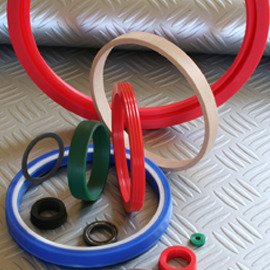Advantages and disadvantages of silicone rubber
Posted on 04/05/2020 Category: General Martins Rubber blog, Latest News, Rubber moulding

Silicones are a family of high-performance materials whose unique molecular structure mean that they can come in many different forms, including liquids, solids, semi-viscous pastes, oils, greases and rubber. We use this versatile rubber material in a range of settings, from visual, highly aesthetic components to food-grade kitchen utensils. In this article, Martin’s Rubber explains the advantages and disadvantages of silicone rubber.
What is silicone rubber?
Silicone is a remarkable material. This semi-organic synthetic rubber (not to be confused with the chemical element silicon) consists of a chain of silicon and oxygen atoms, as opposed to the carbon and hydrogen atoms prevalent in most other types of rubber.
This molecular structure is a mixed blessing in terms of silicone’s properties.
On the one hand, this backbone of siloxane bonds gives silicone its low thermal conductivity, resulting in an extremely heat resistant and thermally stable material. On the other hand, whilst stable and flexible, silicone’s chain is weak, which means it tears easily.
Let’s look at the advantages and disadvantages of silicone rubber in greater detail.
Advantages of silicone rubber
Here are just some of the main advantages of silicone rubber:
Heat resistant
One of the main benefits of silicone rubber is its heat resistance. It offers outstanding high-temperature resistance, with some compounds able to withstand temperatures up to 305 °C. Silicone’s thermal stability means it retains its structure and properties over a wide temperature range. This extends to low temperatures too, which means this synthetic rubber can maintain its flexibility even at -100°C.
Hygienic
Have you ever wondered why so many kitchen utensils are made of silicone? Well, that’s because another advantage of silicone rubber is its non-porous nature. This makes it resistant to bacterial build-up, making silicone particularly useful in food and beverage applications, where food-grade compounds can provide total peace of mind. Silicone is also non-toxic, water-repellent and recyclable at specialised plants.
Disadvantages of silicone rubber
Here are some of the disadvantages of silicone rubber:
Tear strength
One of the major disadvantages of silicone rubber is its poor tear strength. This can be improved with the addition of other ingredients, but it doesn’t naturally offer strength or abrasion resistance, so the application needs to be carefully assessed for the suitability of silicone as a solution.
Cost
Another disadvantage of silicone elastomers is that as a premium product they can come with a similarly premium price tag compared to some other rubber materials. However, this initial outlay is often offset by improvements in uptime and quality control. Again, speaking to a specialist like Martin’s Rubber will enable you to gain a clearer understanding of silicone’s ROI with regards to your specific application.
Like all materials, silicone has its benefits and shortcomings. Despite some of its more impressive qualities, it certainly isn’t applicable for every application. To find out more about the benefits of silicone or to discuss how our rubber moulding services can support your application requirements in more detail, speak to one of our friendly and knowledgeable experts here at Martin’s Rubber. They will be only too happy to offer their advice and guidance.
Contact Martin’s Rubber today on +44 (0) 23 8022 6330 or email [email protected].


